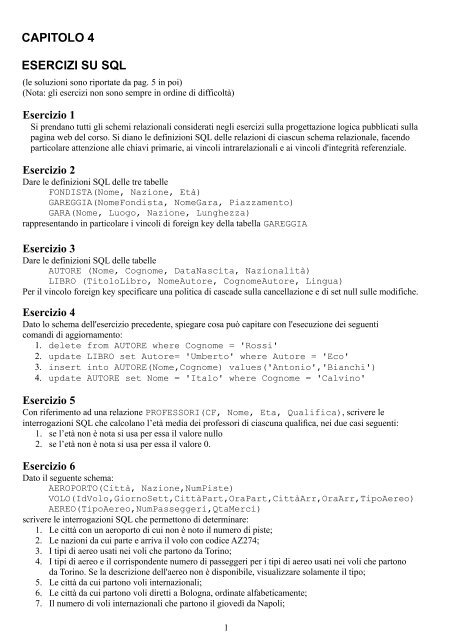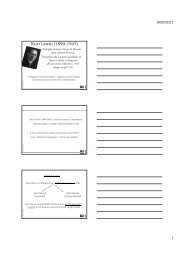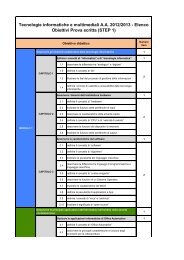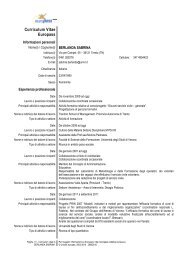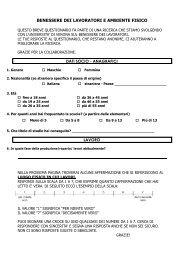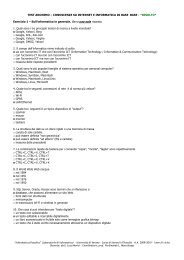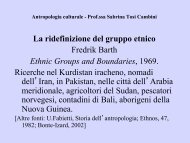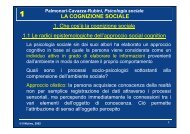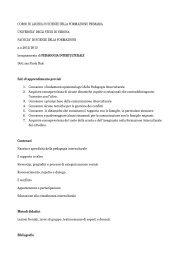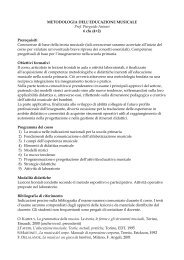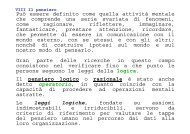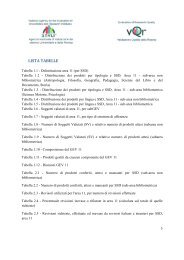Create successful ePaper yourself
Turn your PDF publications into a flip-book with our unique Google optimized e-Paper software.
SOLUZIONIEsercizio 2Create Table FONDISTA(Nome character(20) primary key,Nazione character(30),Età integer)Create table GARA(Nome character(20) primary key,Luogo character(20),Nazione character(20),Lunghezza integer)Create table GAREGGIA(NomeFondista character(20) references FONDISTA(Nome),NomeGara character(20) references GARA(Nome),Piazzamento integer,primary key (NomeFondista, NomeGara))Esercizio 3Create table AUTORE(Nome character(20),Cognome character(20),DataNascita date,Nazionalità character(20),primary key(Nome, Cognome))Create table LIBRO(TitoloLibro character(30) primary key,NomeAutore character(20),CognomeAutore character(20),Lingua character(20),foreign key (NomeAutore, CognomeAutore)references AUTORE(Nome, Cognome)on delete cascade on update set NULL)Esercizio 41. Il comando cancella dalla tabella AUTORE tutte le tuple con Cognome = 'Rossi'. A causa dellapolitica cascade anche le tuple di LIBRO con CognomeAutore = 'Rossi' verranno eliminate.2. Il comando non è corretto: Nome e Cognome sono attributi della tabella AUTORE e non dellatabella LIBRO3. Il comando aggiunge una nuova tupla alla tabella AUTORE. Non ha alcun effetto sulla tabellaLIBRO4. Le tuple di AUTORE con Cognome = Calvino vengono aggiornate a Nome = Italo. A causa dellapolitica set null gli attributi NomeAutore e CognomeAutore delle tuple di Libro conCognomeAutore = Calvino vengono posti a NULL.5
Esercizio 51. Le funzioni aggregative escludono dalla valutazione le ennuple con valori nulli:select Qualifica, avg(Eta) as EtaMediafrom Professorigroup by Qualifica2. E' necessario escludere esplicitamente dal calcolo della media le tuple con il valore che denotal’informazione incompleta:select Qualifica, avg(Eta) as EtaMediafrom Professoriwhere Eta 0group by Qualifica.Esercizio 61. select Cittàfrom AEROPORTOwhere NumPiste is NULL2. select A1.Nazione, A2.Nazionefrom AEROPORTO as A1 join VOLO on A1.Città=CittàArrjoin AEROPORTO as A2 on CittàPart=A2.Cittàwhere IdVolo= ‘AZ274’3. select TipoAereofrom VOLOwhere CittàPart=’Torino’4. select VOLO.TipoAereo, NumPasseggerifrom VOLO left join AEREO on VOLO.TipoAereo=aereo.TipoAereowhere CittàPart= ‘Torino’5. select CittàPartfrom AEROPORTO as A1 join VOLO on CittàPart=A1.Cittàjoin AEROPORTO as A2 on CittàArr=A2.Cittàwhere A1.Nazione A2.Nazione6. select CittàPartfrom VOLOwhere CittàArr= ‘Bologna’order by CittàPart7. select count(*)from VOLO join AEROPORTO on CittàArr=Cittàwhere CittàPart = ‘Napoli’ and Nazione ‘Italia’ andGiornoSett= ‘Giovedì’8.a) select count(*), CittàPartfrom AEROPORTO as A1 join VOLO on A1.Città=CittàPartjoin AEROPORTO as A2 on CittàArr=A2.Cittàwhere A1.Nazione=’Italia’ and A2.Nazione ‘ Italia’group by CittàPart6
) select count(CittàArr)from AEROPORTO as A1 join VOLO on A1.Città=CittàPartjoin AEROPORTO as A2 on CittàArr=A2.Cittàwhere A1.Nazione=’Italia’ and A2.Nazione ‘ Italia’group by CittàPart9. select CittàPartfrom AEROPORTO as A1 join VOLO on A1.Città=CittàPartjoin AEROPORTO as A2 on CittàArr=A2.Cittàwhere A1.Nazione=’Francia’ and A2.Nazione= ‘Italia’group by CittàPartHaving count(*) >2010.a) select CittàPartfrom VOLO join AEROPORTO on CittàPart=Cittàwhere Nazione = ‘Italia’exceptselect CittàPartfrom AEROPORTO as A1 join VOLO on A1.Città=CittàPartjoin AEROPORTO as A2 on CittàArr=A2.Cittàwhere (A1.Nazione=’ Italia ’ and A2.Nazione’ Italia ’ )b) select CittàPartfrom VOLO join AEROPORTO on CittàPart=Cittàwhere Nazione= ‘Italia’ and CittàPart not in( select CittàPartfrom AEROPORTO as A1 join VOLO onA1.Città=CittàPart join AEROPORTO as A2 on CittàArr=A2.Cittàwhere A1.Nazione=’Italia’ and A2.Nazione‘Italia’ )c) select CittàPartfrom VOLO join AEROPORTO as A1 on CittàPart=Cittàwhere Nazione= ‘Italia’ andnot exists ( select *from VOLO join AEROPORTO as A2 on A2.Città=CittàArrwhere A1.Città=CittàPart and A2.Nazione’Italia’ )d) select CittàPartfrom AEROPORTO as A1 join VOLO on A1.Città=CittàPartleft join AEROPORTO as A2on (CittàArr=A2.Città and A2.Nazione=’Italia’)where A1.Nazione=’Italia’group by CittàParthaving count (district A2.Nazione)= 1 )11. select CittàPartfrom VOLO join AEREO on VOLO.TipoAereo=AEREO.TipoAereowhere NumPasseggeri=( select max(NumPasseggeri)from AEREO )unionselect CittàArrfrom VOLO join AEREO on VOLO.TipoAereo=AEREO.TipoAereowhere NumPasseggeri=( select max(NumPasseggeri)from AEREO )7
Esercizio 71. select NomeCantantefrom CANTANTE join ESECUZIONE onCANTANTE.CodiceReg=ESECUZIONE.CodiceRegjoin AUTORE on ESECUZIONE.TitoloCanz=AUTORE.TitoloCanzonewhere Nome=NomeCantante and Nome like ‘d%’2. select TitoloAlbumfrom DISCO join CONTIENE on DISCO.NroSerie=CONTIENE.NroSerieDiscojoin ESECUZIONE on CONTIENE.CodiceReg=ESECUZIONE.CodiceRegwhere ESECUZIONE.anno is NULL3. select NroProg, TitoloCanz, NomeCantantefrom (CONTIENE left join CANTANTE onCONTIENE.NroSerieDisco=CANTANTE.CodiceReg)join ESECUZIONE on CONTIENE.codiceReg= ESECUZIONE.CodiceRegwhere NroSerieDisco=78574order by NroProg4. select Nomefrom AUTOREwhere Nome not in ( select NomeCantantefrom CANTANTE )unionselect NomeCantantefrom CANTANTEwhere NomeCantante not in ( select Nomefrom AUTORE )5. select NroSeriefrom DISCOwhere NroSerie not in( select NroSerieDiscofrom CONTIENE join CANTANTE as S1 onCONTIENE.CodiceReg=S1.CodiceRegjoin CANTANTE as S2 on CONTIENE.CodiceReg=S2.CodiceRegwhere S1.NomeCantanteS2.NomeCantante) and NroSerie in( select NroSerieDiscofrom CONTIENE join ESECUZIONE on CodiceReg= CodiceRegjoin DISCO on DISCO.NroSerie=CONTIENE.NroSerieDiscowhere ESECUZIONE.Anno=3)6. select distinct NomeCantantefrom CANTANTEwhere NomeC not in( select S1.NomeCantantefrom CANTANTE as S1where CodiceReg not in( select CodiceRegfrom CANTANTE S2where S2.NomeCantante S1.NomeCantante ) )8
7. select NomeCantantefrom CANTANTEwhere NomeCantante not in( select S1.NomeCantantefrom CANTANTE as S1 join ESECUZIONE on CodiceReg=S1.CodiceRegjoin CANTANTE as S2 on CodiceReg=S2.CodiceReg )where S1.NomeCantante S2.NomeCantante)Esercizio 81. select *from Studentiwhere matricola not in ( select distinct studentefrom Esami );2. select *from Studenti join Esami on matricola=studentewhere voto > any ( select votofrom Esami join Studenti on studente = matricolawhere cognome = ’pitagorico’and nome = ’archimede’);3. select distinct s.nome, s.cognomefrom Studenti s,Esami e1 join Esami e2 on (e1.studente = e2.studente)where e1.codiceCorso > e2.codiceCorso and e1.voto >= 18 ande2.voto >= 18 and s.matricola = e1.studente;4. select s.nome, s.cognome, count(*), avg(voto)from Studenti s, Esami ewhere s.matricola = e.studentegroup by s.nome, s.cognomeEsercizio 91. update Impiegato set Stipendio= Stipendio+200where Stipendio < 300002. update Impiegato set Stipedio= Stipendio*0.95where Stipendio > 30000Esercizio 10Esercizio 11create table Prodotti (codice numeric not null primary key,nome char(20) not null,categoria char(20) not null);9
create table Vendite (codiceProd numeric not null references Prodotti(codice),data date not null,incasso numeric not null,primary key (codiceProd, data));delete * from Prodotti;insert into Prodotti values(101,A,Bevanda);insert into Prodotti values(102,B,Bevanda);insert into Prodotti values(103,C,Pasta);insert into Prodotti values(104,D,Biscotti);delete * from Vendite;insert into Vendite values(101,2008-11-24,2000);insert into Vendite values(101,2008-11-25,1000);insert into Vendite values(102,2008-11-23,2500);insert into Vendite values(102,2008-11-24,4000);insert into Vendite values(103,2008-11-25,1320);Esercizio 121. select A.targa, A.tipologia, A.lunghezza, T.kmPercorsi * TA.costoAlKmfrom Transito T join Automobile A on (T.auto = A.targa)join Tariffa TA on (TA.tipoAuto = A.tipologia);2. select A.targa, A.tipologia, A.lunghezzafrom Automobile A join Transito T on (T.auto = A.targa)join transito T2 on (T1.auto = T2.auto)where T1.codice > T2.codice;3. select A.targafrom Automobile A join Transito T on (A.targa = T.auto)left join Transito T2 on (T1.auto = T2.auto)where T1.codice > T2.codiceexceptselect A.targafrom Automobile A join Transito T on (A.targa = T.auto)join Transito T2 on (T1.auto = T2.auto)where T1.codice > T2.codice and (T1.km T2.Km);4. select A.*, T.*, T.KmPercorsi * TA.costoKMfrom Transito T join Automobile A on (T.auto = A.targa)join Tariffa TA on (TA.tipoAuto = A.Tipologia)where (T.KmPercorsi / (T.uscita-T.ingresso)) > 140Esercizio 131. select distinct Cittafrom Aeroporti join Voli on Aeroporti.Codice = Voli.Destinazionejoin Aerei on Aerei.Codice = Voli.Aereowhere Aerei.NumeroPosti >= 200;2. select Citta, count(*)from Aereoporti join Voli on Aeroporti.Codice = Voli.Destinazionegroup by Citta10


